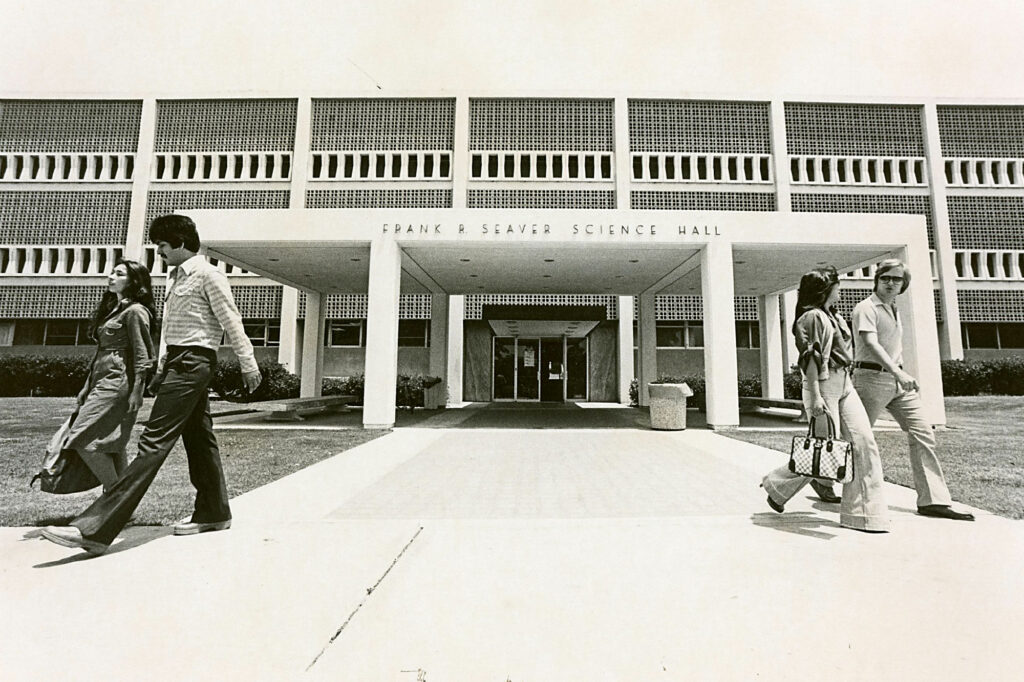
Fifty years ago, in March 1972, LMU President Donald P. Merrifield, S.J. announced the merger of the university’s seven science and engineering programs under one roof. A physicist by trade, Merrifield pointed to a range of public issues — the growth of technology, diminishing natural resources, pollution and public health, for example — that students would confront in the future and that restructuring could better prepare them to address.
The year 1972, in fact, was momentous regarding the policy areas that Merrifield named. “The Limits to Growth,” a landmark report on the dangers of unchecked consumption and limited resources, was published in March. The Declaration of the United Nations Conference on the Human Environment was issued in June. In the U.S., the Clean Water Act was passed in October.
Long before the word interdisciplinarity was commonly used, Merrifield identified it as crucial to science education.
Society’s problems, Merrifield wrote in his announcement of the establishment of the College of Science and Engineering, “can best be solved by teams of individuals, including scientists and engineers, who are not only competent in their fields of specialization, but are aware of and sensitive to the obvious and more subtle aspects of the overall problems.”
Michael Mulvihill ’58, professor emeritus of civil engineering, was a young faculty member at the time. “It made sense to combine the sciences, mathematics and engineering departments because of their compatibility and opportunities for interaction.” The faculty, he says, have consistently worked to provide a curriculum that speaks to problems and issues students will face in their careers.
Long before the word interdisciplinarity was commonly used, Merrifield identified it as crucial to science education.
And Tina Choe, dean of the Seaver College, says it remains so today.
“Some of our majors within science and engineering are quite interdisciplinary in their foundation,” Choe says. The LMU Coastal Research Institute examines the environmental health of the Santa Monica Bay through the work of biology, chemistry and engineering students and faculty. A seafood traceability project that involves identifying mislabeled seafood combines efforts from faculty and students in biology, physics, chemistry and
engineering.
Yet, Choe believes proficiency in interdisciplinary studies must go hand in hand with a strong foundation within the science and engineering disciplines. “You can’t be interdisciplinary when you don’t have a depth of understanding of the discipline,” she explains.
“If we can help our students to figure out that they’re going to get the depth of knowledge but they’re also going to learn how to apply this knowledge in a broader sense that requires interdisciplinary thinking,” she adds, “then that’s the key.”
On Sept. 16, 2022, the LMU community celebrated the Seaver College’s half-century of service at a gathering during the LMU Alumni BBQ Weekend. In 2015, the Seaver College’s science capabilities were dramatically upgraded through the completion of the $110 million Bruce Featherston Life Sciences Building. The next major project will be the state-of-the-art Engineering Innovation Complex, which will serve the LMU community and provide a hub for industry leaders to gather and share ideas.
To support the Frank R. Seaver College of Science and Engineering, contact Melissa Watkins, executive director of major gifts, at Melissa.Watkins@lmu.edu.
caption: LMU was ahead of its time 50 years ago in 1972 when it pulled engineering, math and sciences in under one roof of the College of Science and Engineering.
